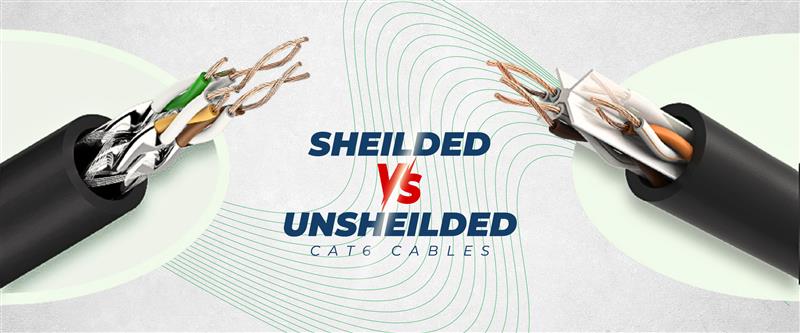How to Choose Cat6 Plenum Cable

In today’s fast-moving tech world, choosing the right cabling system is essential for efficient, safe, and future-proof network installations. Cat6 plenum cables have emerged as a popular choice in commercial, institutional, and even advanced residential settings due to their high performance and enhanced safety features. Designed specifically for air-handling spaces, these cables help reduce fire hazards while supporting high-speed data transmission—making them a critical component of modern networking infrastructures.
Table of Contents
Why Cat6 Plenum Cable?
When setting up a reliable network infrastructure, selecting the right cable is crucial. A Cat6 plenum cable stands out as an efficient choice for those looking to enhance their internet connection in commercial buildings, datacenters, and educational institutions. Cat6 plenum cables offer several key benefits:
- High-Speed Data Transmission:
Cat6 cables offer improved performance, reduced crosstalk, and greater capabilities. With a frequency of 250MHz, they support speeds of 1Gb over distances of 328Feet (100meters), making them ideal for high-speed networking in today’s world. The inclusion of IEEE802.3bz allows for advanced speeds like 2.5GBase-T and 5GBase-T under ideal circumstances. - Enhanced Safety:
A plenum-rated jacket is designed for areas with airflow and air circulation, making it a fire-safe solution. These cables have flame retardant properties, often using PVC and FEP insulation to withstand higher temperatures while minimizing toxic smoke and reducing the spread of flames. - Reduced Interference:
Improved construction minimizes crosstalk and electromagnetic interference (EMI), maintaining signal integrity.
Choosing the Right Environment
When purchasing Cat6 plenum cables, understanding your environment is crucial. Whether you’re setting up in a home, business, or offices, you’ll need to determine the presence of EMI to make the right choice. Before Installing the cables, evaluate your installation environment:
- Low-Interference Areas:
Some areas, like restaurants, shops, and the majority of homes, don’t have significant signal interference, making unshielded cable a great option. These installations use UTP structures with twisted pairs, which don’t have extra shielding around the wires, ensuring seamless connectivity without unnecessary cost. However, if you’re looking to wire a space with different conditions, like factories, hospitals, or labs, you’ll need to safeguard your installations against interruption. - High-Interference Areas:
Environments such as factories, hospitals, or labs, where heavy EMI from electrical equipment is present, benefit from shielded Cat6 plenum cables. These cables, often built with foil or braid shielding (F/UTP or S/FTP), provide an extra layer of protection against signal disruption.
Understanding your environment helps ensure you choose the cable type that offers both performance and cost-effectiveness for your specific setup. If you’re unsure, let’s make sure you don’t fall into the wrong choice—double-check your environment before moving over to your final decision
Types of Cat6 Plenum Cables
When selecting Cat6 plenum cables, it’s essential to understand the various types available based on shielding, conductor type, and packaging. Depending on the installation environment and interference levels, Cat6 plenum cables come in shielded and unshielded variants, each offering unique benefits in terms of performance, durability, and signal integrity. Here’s a closer look:
Shielded Cat6 Plenum Cable
- Construction & Benefits:
- Incorporates additional foil or braided shielding around each twisted pair or the entire cable.
- Ideal for areas with high EMI, ensuring minimal crosstalk and improved signal integrity.
- Often used in environments where regulatory compliance for fire safety is critical.
- Recommended For:
- Data centers, hospitals, and industrial installations.
Unshielded Cat6 Cables
- Construction & Benefits:
- Built as Unshielded Twisted Pair (UTP) cables, these are more cost-effective.
- Suitable for low-interference environments where robust shielding is not necessary.
- Maintain excellent performance over standard distances while offering flexibility and ease of installation.
- Recommended For:
- Homes, small offices, and retail spaces.
Shielded vs. Unshielded: Which is Right for You?
- Shielded Options:
Choose shielded cables when:- Your installation is in an environment with significant electromagnetic interference (EMI).
- You need the highest levels of signal integrity for mission-critical applications.
- The installation area is prone to external noise, such as near power lines or industrial equipment.
- Compliance with stringent fire safety and performance standards is required.
- Unshielded Options:
Opt for unshielded cables when:- Budget constraints are a consideration.
- The installation environment is low in interference, such as in residential or small office settings.
- Flexibility and ease of installation are prioritized.
- The network demands standard performance without the need for advanced shielding.
Always assess your installation’s unique requirements before making a final decision. Jourmik is selling UTP, 550MHz Ethernet Cable, Shop Now

Specifications & Safety Standards
Cat6 plenum cables are engineered to meet rigorous performance and safety benchmarks:
- Performance Specifications:
- Cat6 plenum cables are designed for high-performance networking in commercial spaces.
- Made from high-quality PVC, ensuring durability and chemically resistant properties.
- Emits less smoke in case of a fire, reducing exposure to harmful fumes.
- Offers excellent electrical performance, ensuring stable and efficient connectivity.
- Can operate in extreme temperatures, ranging from -25 to 125 degrees Celsius.
- Suitable for installations in office buildings, data centers, and areas requiring enhanced safety.
- Ensures long-term reliability and compliance with fire safety regulations.
- Safety Standards:
- Plenum-rated jackets (often made from PVC or FEP) ensure low-smoke emission and flame retardancy.
- Compliance with standards such as UL910 guarantees that the cable meets the most stringent fire safety requirements for plenum spaces.
Advantages Of Using Cat6 Plenum Cables
- Safety & Compliance:
Their fire-retardant properties and low-smoke emissions help maintain a safe environment, especially in enclosed spaces. - High Performance:
Support for advanced networking speeds makes them future-proof for evolving technologies. - Durability:
Constructed to withstand environmental stress, they ensure long-term reliability in critical installations. - Versatility:
Available in various configurations (shielded, unshielded, pure copper, CCA) to suit different network demands.
Cost Consideration
While Cat6 plenum cables typically come at a higher cost than standard cables, the investment is justified by:
- Long-Term Reliability:
While the price may seem high, the benefits far outweigh the cost, especially in terms of long-term reliability and health considerations. - Safety Benefits:
These cables come with high-quality construction, satisfying strict safety standards by employing special material for the jacket, usually PVC, which makes them a top choice for buildings that require fire-resistant wiring. - Future-Proofing:
Customers often prefer to acquire these cables because of their excellent characteristics, such as durability and top-tier performance. Their qualities make them stand out, ensuring that your network setup is safe, efficient, and future-proof.
Pros and Cons of Cat6 Plenum Cable
Pros
- Superior Performance:
Cat6 plenum cables contain four pairs of solid conductors within a plenum-rated jacket, with the pairs separated by a spline, ensuring better signal integrity.
It can transmit 10 gigabits per second over short distances, making them ideal for high-speed networking needs.
- Enhanced Safety:
Plenum-rated jackets meet rigorous fire standards, reducing risk in emergency situations. - Reliable Connectivity:
Enhanced shielding provides superior capabilities, minimizing electromagnetic interference (EMI) and radio frequency interference (RFI) for reliable connections. - Versatile Applications:
Suitable for a wide range of environments, from commercial buildings to industrial installations.
Cons
- Higher Cost:
The advanced materials and construction mean these cables are more expensive than lower-rated alternatives. - Distance Limitations:
A major disadvantage is that performance slows over long distances exceeding 164 feet, whereas 95 percent of installations require runs shorter than 150 feet. - Installation Considerations:
Designed for plenum space, meaning they are mainly suited for building installations where air circulation is needed for heating and conditioning. - Fire-resistant properties:
The plenum-rated jacket outside is made from low-smoke PVC (polyvinyl chloride), which incorporates fire-resistant properties, but this material adds to the cost.
Best Types of Cat6 Plenum Cables
When selecting the right Cat6 plenum cable, it all depends on your specific needs and the factors you should consider before making a purchase. The network requirements should be your first checkpoint—evaluate your current and future usage. If you anticipate needing beyond 1 Gbps, then you should consider an upgrade. The length of the cable run also plays a huge role in performance. A poorly chosen cable can limit speed and cause bottlenecks. That’s why it’s important to choose an appropriate cable for your application to ensure seamless connectivity.
Your budget is another critical aspect. Cat6 plenum cables are generally priced more than standard cables due to their fire-resistant jacket material. However, you shouldn’t compromise quality over cost.
At Jourmik, we offer two premium options: Cat6 plenum CCA and Cat6 plenum pure copper. These cables offer the necessary features while staying within a reasonable price range. To determine the best fit, find a balance between speed, durability, and cost-effectiveness.
Expert Guidance for the Best Choice
Choosing the right Cat6 plenum cable is a vital step in ensuring a safe and efficient network for your infrastructure. Whether you’re setting up cabling in buildings with plenum spaces or upgrading your network, having a clear understanding of the types, applications, and specifications of these cables can help you make informed decisions. Your cabling needs will depend on several factors, such as compliance standards, fire safety ratings, and installation methods. If you’re unsure about selecting the right cable for your project, it’s always best to seek assistance from qualified network cabling professionals who can guide you based on your specific requirements.
Get Expert Help
For further assistance or to discuss your specific requirements, contact our network cabling experts at Jourmik. We specialize in Cat6 plenum cable solutions and are ready to help you choose the best product for your project.
Call us toll-free at +1 888 413 7488 or visit our website for more information.
FAQs
1. How do I know if my Cat6 is plenum rated?
Check the cable jacket for markings like “CMP” (Communications Plenum), which indicates plenum rating. Plenum-rated cables are specifically designed for use in air-handling spaces and meet strict fire safety standards.
2. Does Cat6 need to be plenum rated?
Cat6 cables need to be plenum-rated if they are installed in plenum spaces (e.g., drop ceilings or raised floors) where air circulates. In non-plenum areas, riser-rated (CMR) cables may suffice.
3. What makes a cable plenum rated?
Plenum-rated cables are made with fire-retardant materials (like PVC or FEP) that emit low smoke and toxic fumes when exposed to fire. They meet safety standards such as UL910 for use in air-handling spaces.
4. How to pick Cat6 cable?
Consider factors like shielding (UTP vs. STP), conductor size (23AWG vs. 24AWG), and the installation environment (plenum vs. riser). Choose based on your speed, interference, and safety requirements.
5. How do you identify plenum space?
Plenum spaces are areas used for air circulation, such as drop ceilings, raised floors, or HVAC ducts. These spaces require plenum-rated cables to meet fire safety regulations.
6. Is CMR cable plenum rated?
No, CMR (Communications Riser) cables are not plenum-rated. They are designed for vertical riser applications and do not meet the same fire safety standards as plenum-rated (CMP) cables.
7. What is the difference between Cat6 riser and Cat6 plenum?
Cat6 riser (CMR) cables are for vertical runs between floors, while Cat6 plenum (CMP) cables are for air-handling spaces. Plenum cables have stricter fire safety standards and are more expensive.
8. Where is plenum cable required?
Plenum cables are required in air-handling spaces, such as drop ceilings, raised floors, and HVAC ducts, where fire safety and low smoke emissions are critical.
